This post contains affiliate links.
Inadvertently seeing art masterpieces while playing card games generates interest from kids for art history. I knew only a few art-decorated playing card games until I searched them for you. And here is what I found.
I found 18 art history playing card games. Some of them span the history of painting, while others focus on a specific art movement (impressionism) and others on a specific artist. Many of them can be used beyond playing standard card games and become powerful teaching tools by using additional rules.
First I have to stress that in this post I only cover card games that have a different painting on each card. They allow introducing many different artworks. I will not cover any card decks that only have a card back made with a well-known painting.
That being said, I could find two different types of playing card decks:
- 7 decks which present paintings from many different artists: they enable to develop an understanding and appreciation of art history and are very useful in my opinion for teaching
- 11 decks which focus on a specific artist and enable to dive deep into his/her artworks: they are useful mainly if you who want to focus on this artist, or because you want to show the evolution of the works of an artist throughout his/her career
7 Playing Card Decks with Artwork from Multiple Artists
Bridgeman Art Library Art Pack Playing Cards (Piatnik)
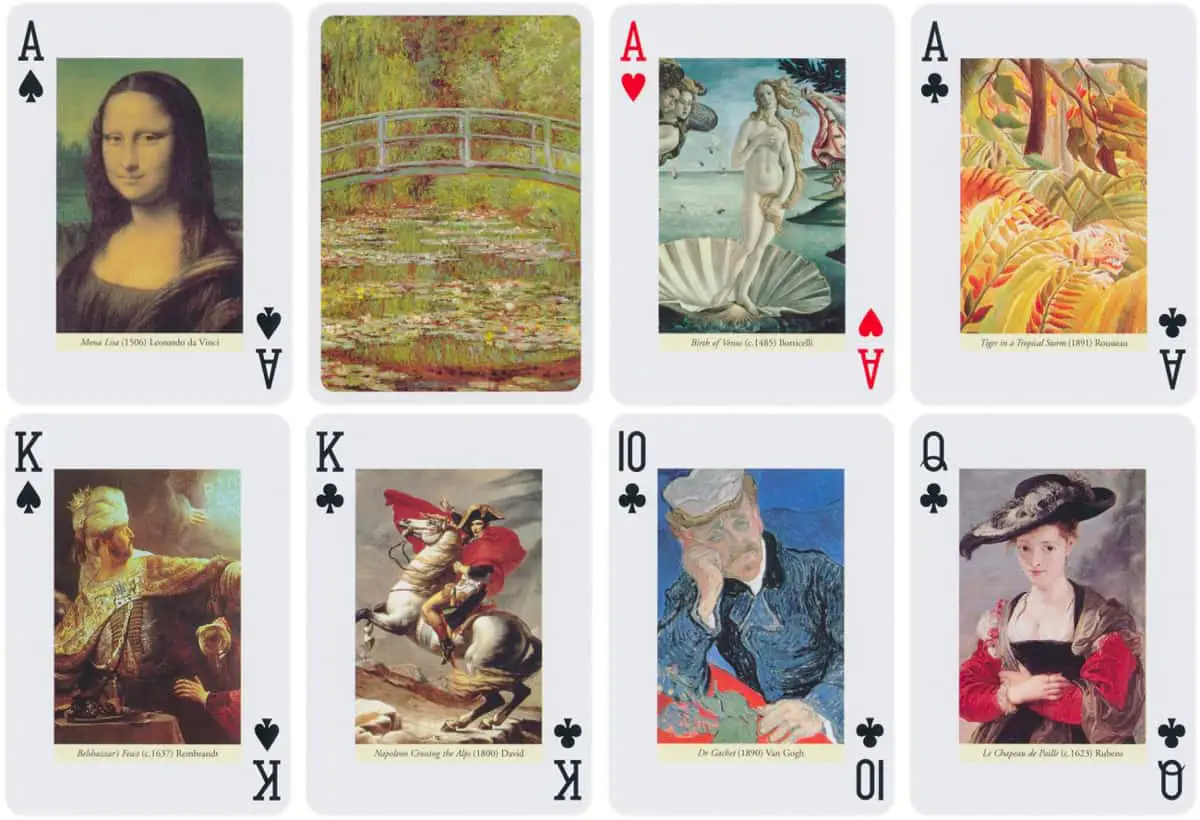
The Art Pack playing card (made in collaboration with the Bridgeman Art Library) is really great:
(made in collaboration with the Bridgeman Art Library) is really great:
- The paintings are well reproduced, making the card set beautiful
- The choice of paintings includes extremely famous paintings of the greatest masters (the Bridgeman Art Library is specialized in managing reproduction rights for artworks worldwide), exhibited in the best museums of the world (Louvre, Musée d’Orsay, Gemäldegalerie, KHM, National Gallery, Victoria and Albert Museum, Wallace Collection, Palazzo Pitti, Uffizi, Gallery dell’Accademia, Sistine Chapel, Museum of Fine Arts, MET…).
- Good cardstock (Piatnik is a reputable card manufacturer)
- The following information is given below each reproduction:
- The name the painting
- The name of the author
- The date the painting was made
It provides an easy way to introduce art history and masterpieces to children. You can either:
- Use the game as a standard playing card set to play whatever game you want (war, go fish, poker…)
- Use the information on the cards to use them as Flashcards, or create your own learning games
So I very highly recommend the Bridgeman Art Library Art Pack (from 5-year-old and up).
Kunst Historisches Museum Art Pack Playing Cards (Piatnik)

This art deck featured a selection of 55 famous artworks that belong to the collections of the Kunst Historisches Museum in Vienna. It has been co-developed by Piatnik and the Kunst Historisches Museum
featured a selection of 55 famous artworks that belong to the collections of the Kunst Historisches Museum in Vienna. It has been co-developed by Piatnik and the Kunst Historisches Museum (Vienna).
(Vienna).
There are pieces by Bruegel, Raphael, Vermeer, Rembrandt, van Eyck, Bosch, Dürer, Mabuse, David and more! But as these pieces are from the KHM only, do not expect such famous paintings as with the Bridgeman Art Library Art Pack.
As with the Art Pack made by Piatnik with the Bridgemen Art Library, the name of the artist and the title of the art piece are mentioned below the painting, but unfortunately, not the date of the painting. As a result, it is not possible to play chronological games with it such as “Timeline” (a popular game made by Asmodee).
I do recommend this game though (and the artworks are reproduced almost on the full size of the card, which is very nice)!
Portraits Pack from the Kunsthistorisches Museum Vienna (Piatnik)
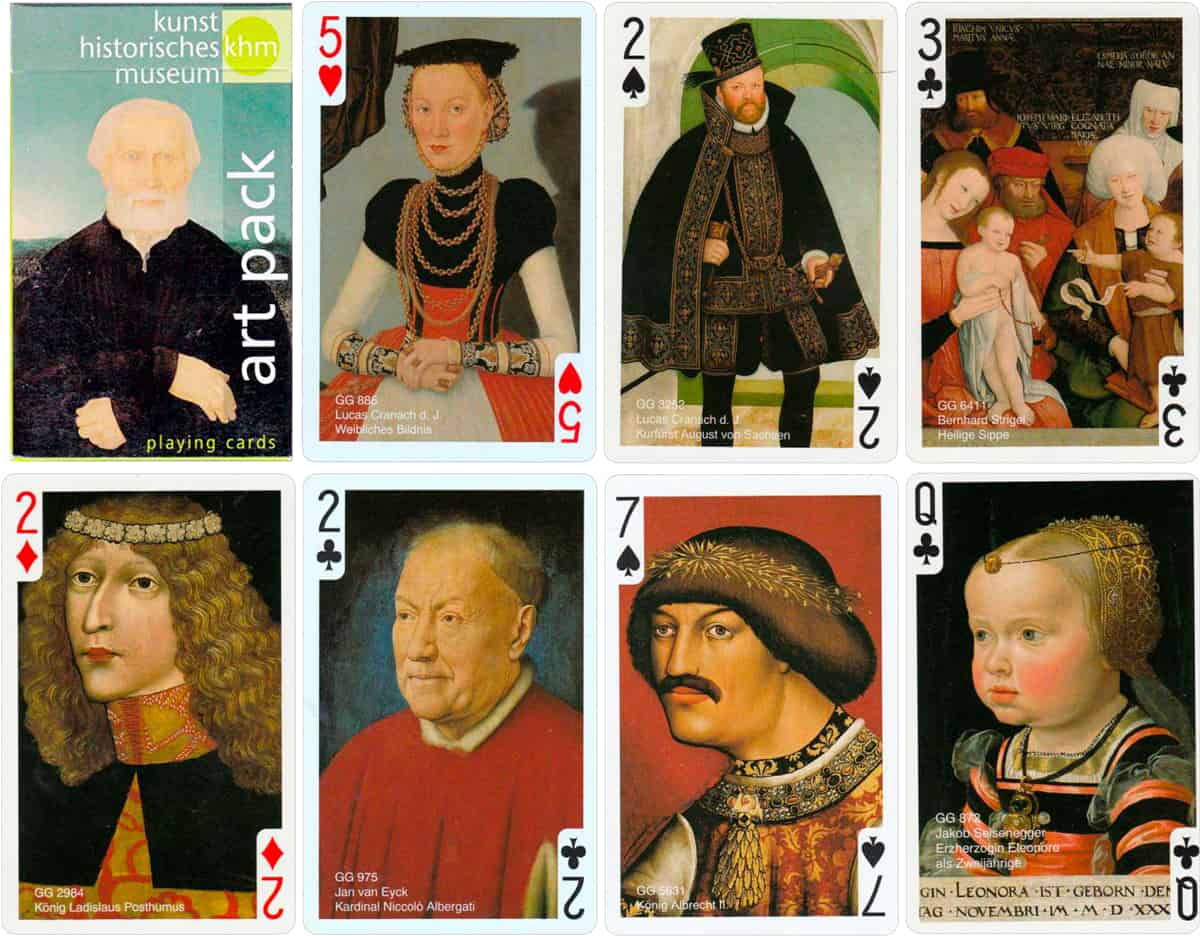
I doubt that you will be interested in this Portraits pack game unless you are teaching german or focusing on german history: the portraits in the pack are great, but there is not enough variety to interest most students I am afraid:
game unless you are teaching german or focusing on german history: the portraits in the pack are great, but there is not enough variety to interest most students I am afraid:
- The names of the peoples portrayed are in german
- The name of the painter and who was the person who was portrayed are written on the card, but unfortunately not the date the painting was made!
- Only portraits from the KHM museum. The KHM would not partner with other museums to propose a game with portraits spanning more diverse historical periods and countries in Europe.
Impressionist Masterpieces Playing Cards (Piatnik)
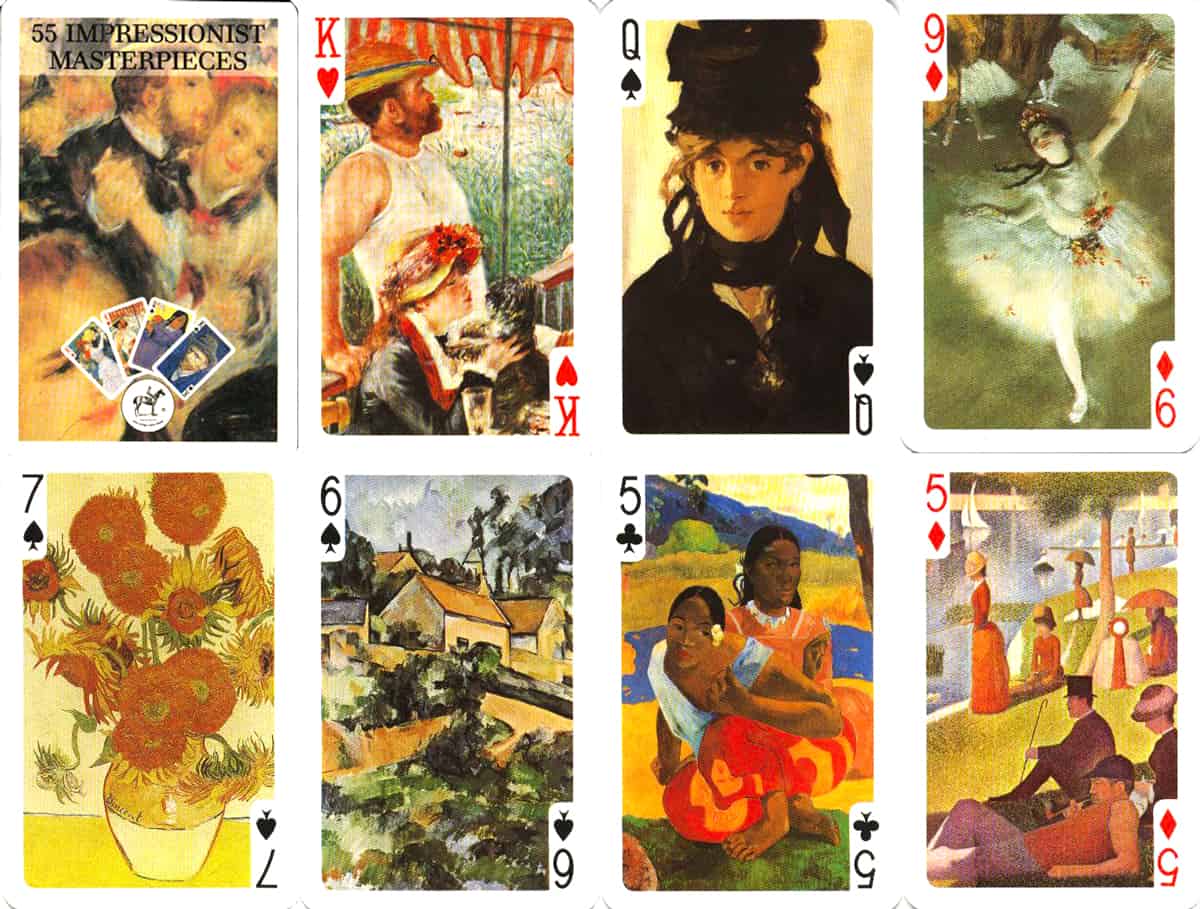
Piatnik also proposes a standard Impressionist Masterpieces Playing Cards Deck. It features 55 of the finest impressionist masterpieces. The choice of the artworks is very good, as well as the quality of the reproductions, as they fill most of the cards.
Deck. It features 55 of the finest impressionist masterpieces. The choice of the artworks is very good, as well as the quality of the reproductions, as they fill most of the cards.
Piatnik could have put some information under each artwork, but they did not do that (contrary to the “Art Packs” discussed before). This is a pity as you lose much of the educational value that you have with this information.
I recommend these cards even if Piatnik has lost an opportunity to make this game even better.
Would you like it if I made a PDF index of the cards in this game with the card value / the name of the painter / the title of the painting / the date it was painted? Would be cool no?
Self Portraits Playing Cards (Piatnik)

This is a really unique playing card game. It contains 52 self-portraits by famous painters . Each of them has the name of the painter and the date the artwork was made written on the left-hand side of the partwork.
. Each of them has the name of the painter and the date the artwork was made written on the left-hand side of the partwork.
I really recommend this self-portraits game as it is a way to introduce different notions to students:
- The names of these famous painters
- An introduction to their styles of painting, and as a result:
- To the many art movements, they belonged to
- And to the many different interpretations of a given painting genre (self-portrait)
Timeline Louvre (Asmodee)

This Timeline Louvre made by Asmodee and the Louvre Museum in Paris is part of the “Timeline” series of games by Asmodee.
made by Asmodee and the Louvre Museum in Paris is part of the “Timeline” series of games by Asmodee.
It is the same rule as the other “Timeline” games. The objective for the players is to get rid of their cards by placing them in the right chronological order with the cards already on the table (but they do not know the dates for the cards they have in hand, as the dates are written on the back of the cards).
The game contains 55 cards, featuring artworks in the Le Louvre collections and events regarding them, and a pedagogical booklet (in French). They span from antiquity (Cuneiform tablets, Venus de Milo…) to contemporary art.
I recommend Timeline Louvre! Timeline is a very popular game for a reason, and the artworks from the Louvre collections are major ones.
Korean Art Playing Card Game
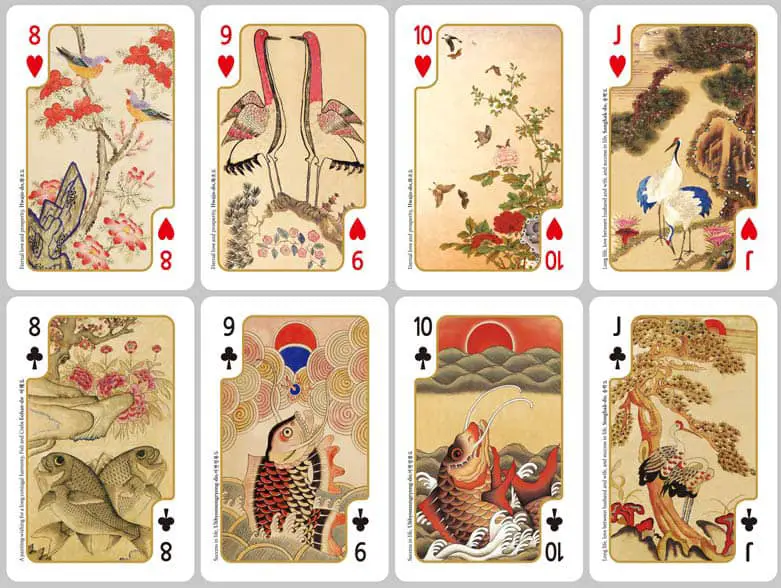
This Korean Joseon Kingdom Art history card game is very original and features 54 Korean paintings of the Joseon Kingdom Dynasty (1392-1910) commonly called Minhwa.
is very original and features 54 Korean paintings of the Joseon Kingdom Dynasty (1392-1910) commonly called Minhwa.
Minhwa is an art form used to decorate households and outer places. It purposefully ignored rules of perspective and composition. The folk paintings also celebrated good fortune, health, and longevity, and drew subject matters from Shamanism, Taoism, Buddhism, and Confucianism, incorporating nature imagery as well as religious portraits.
The paintings’ subjects include clouds and dragons (Unyong Do), pine trees and cranes (Songhak Do), phoenixes (Bonghwang Do), peony blossom (Moran Do), flowers and birds (Hwajo Do), sea creatures (Eohae Do), books (Chaekga Do).
11 Playing Card Decks with Artwork from a Single Artist
Old Masters Playing Card Decks
Leonardo Da Vinci Playing Cards (Piatnik)
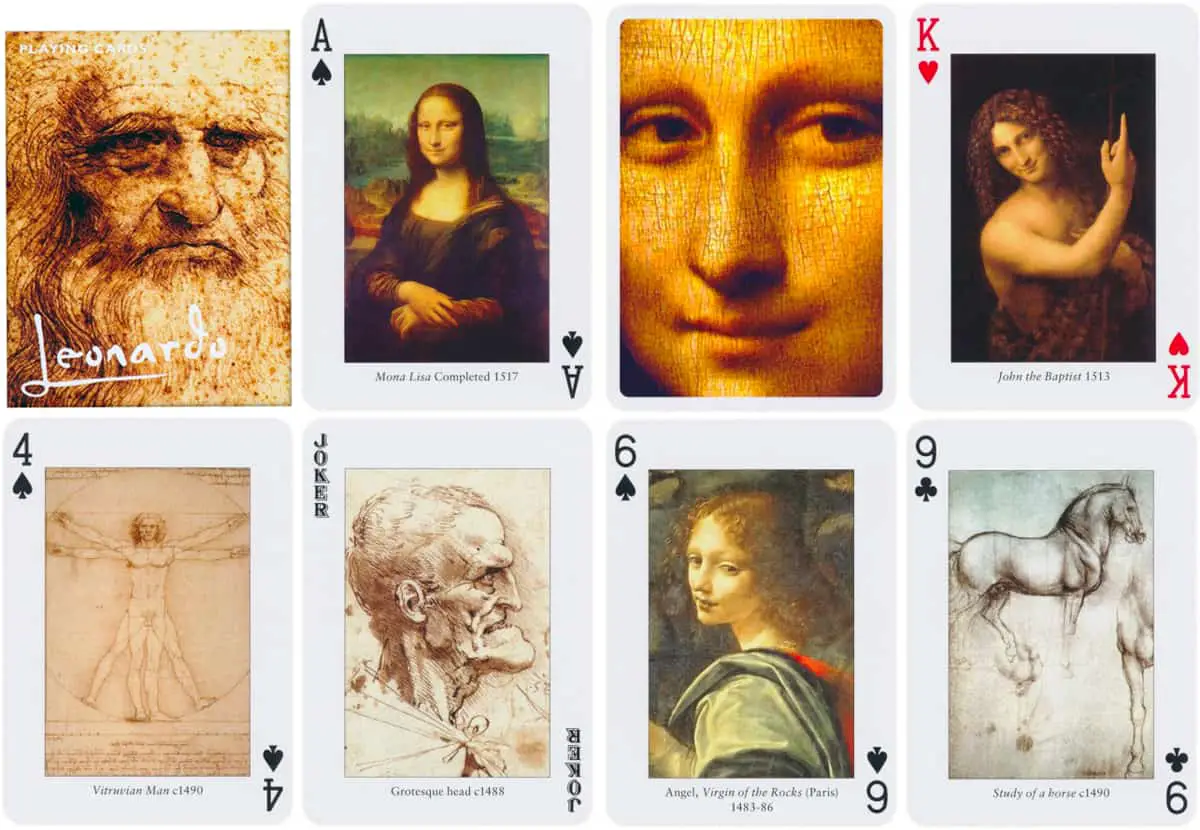
This Leonardo Da Vinci playing cards deck is interesting, as the artworks are displayed sometimes in their entirety, but sometimes some cards display specific details of the artwork, zooming on interesting parts.
There are paintings as well as drawings, as you can see.
Both the title and the date the artwork was made are written below the artworks.
Pieter Bruegel Playing Cards (Piatnik)

Pieter Bruegel was one of the greatest Flemish (Netherlands) artists of his time. His paintings are intriguing and feature various subjects spanning from everyday life to landscape and religious themes.
This Pieter Bruegel Painting playing cards deck is very good, as there is a good variety of well-chosen paintings, and the title and date of each artwork are written under it. Bruegel’s paintings lend themselves to interesting analysis, as they depict life in the middle ages.
deck is very good, as there is a good variety of well-chosen paintings, and the title and date of each artwork are written under it. Bruegel’s paintings lend themselves to interesting analysis, as they depict life in the middle ages.
So for me, the Pieter Bruegel Playing Cards are another really recommended game!
19th / 20th / 21st century Art Playing Card Decks
Frida Kahlo Playing Cards (Piatnik)
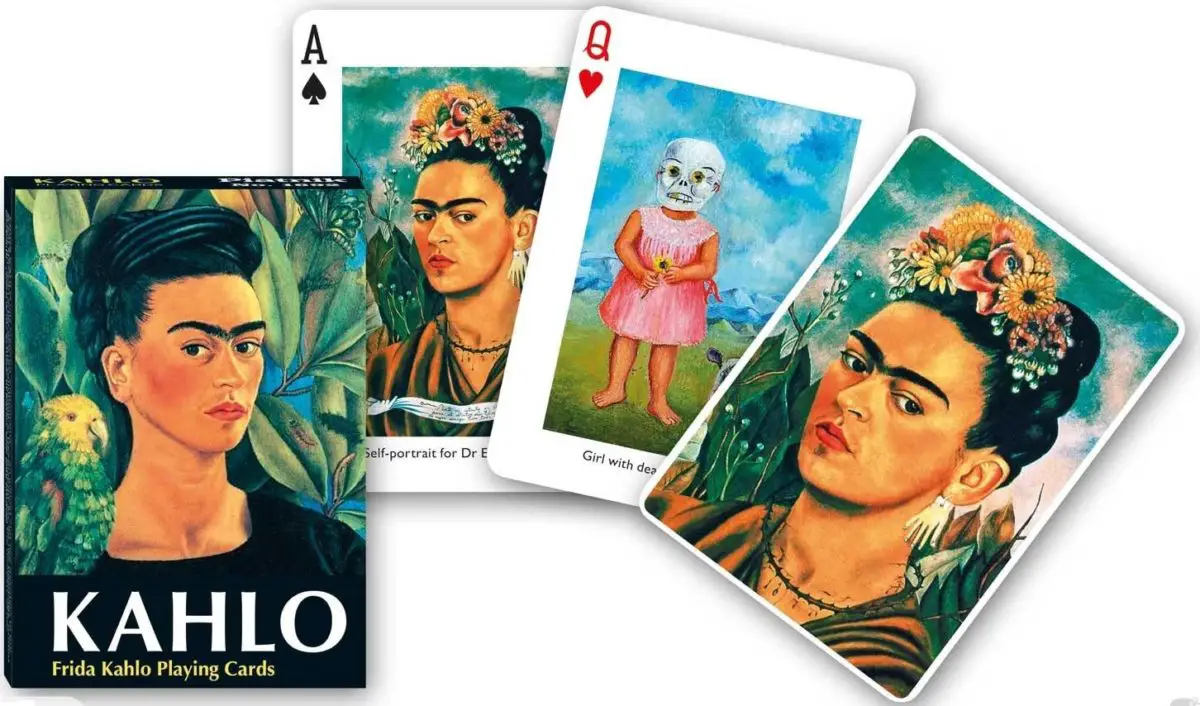
The wonderful naive paintings from Frida Kalho are superb in this Frida Kahlo playing cards deck, especially the portraits, the nature and elements from Mexico where she lived.
deck, especially the portraits, the nature and elements from Mexico where she lived.
This is another very nice game from the educational point of view, as Frida Kahlo’s works were not only beautiful and accessible to everyone, but also are interesting to analyze with students. It is easy to collect information about them as the title of the painting is written under each reproduction.
Claude Monet Playing Cards (Piatnik)
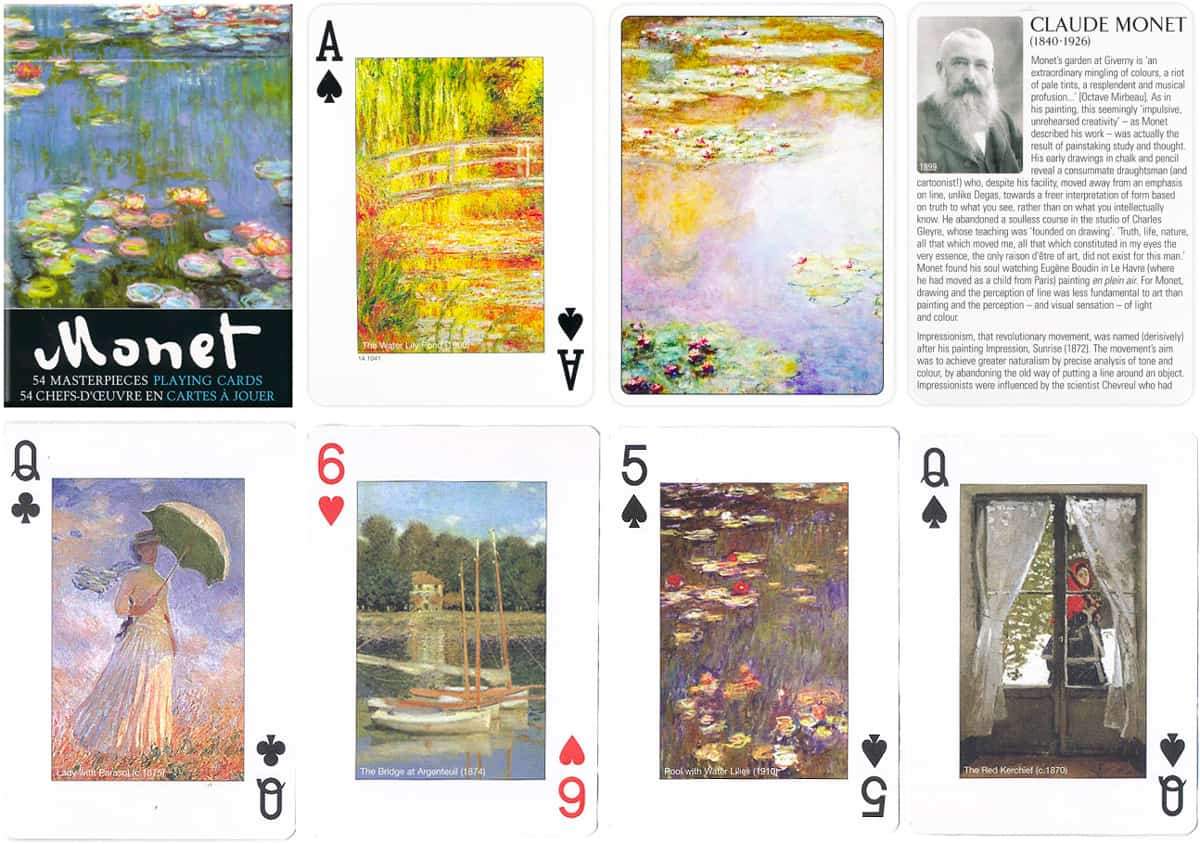
Monet was one of the founders of the Impressionist Movement. This deck is good from an educational point of view:
- The title and date of each painting are written on each card.
- The cards are of good quality with nice reproductions
- Very good choice of the artworks, showing the diversity of subjects painted by Monet
Van Gogh Playing Cards (Piatnik)

This is a gorgeous card deck from maybe the most well known of the impressionists. I am a bit biased as I love Van Gogh, but the reproductions are good, well-chosen, the painting’s title and the date they were made are mentioned, so this a really cool game in my opinion. Another good one from Piatnik really!
Salvador Dali Playing Cards (The Dali Museum, St Petersburg)

This Dali Museum Salvador Dali playing cards deck features The Disintegration of The Persistence of Memory on its cover, which represents a reflection upon the fear of destruction during the Nuclear Age.
deck features The Disintegration of The Persistence of Memory on its cover, which represents a reflection upon the fear of destruction during the Nuclear Age.
The reproductions are a bit small, but I recommend the game though (it has the artworks’ titles on the cards).
Georgia O’Keeffe Playing Cards (Piatnik)
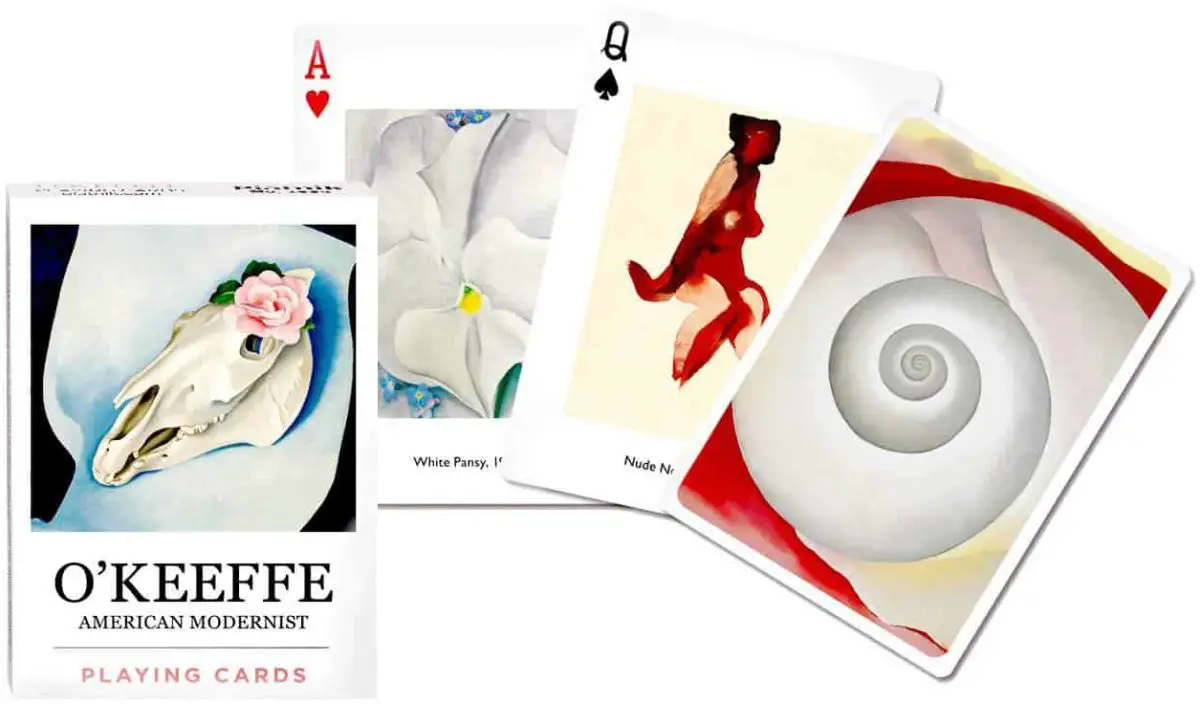
Georgia O’Keeffe was a visionary painter of Mexico, nature, New York and of flower studies. the game also contains portraits by her husband Alfred Stieglitz. The Georgia O’Keeffe playing cards (54 cards) feature a diverse choice of her artworks, with the artwork’s title on each card.
Banski Playing Cards (Piatnik)

Graffiti art is interesting to discuss with students, as they can be in direct contact with it much more often than with traditional fine art.
So this Banski Playing Cards game is a good idea in my opinion. I just regret that there are no “pseudo-titles” under the artworks. The reason why I would like to have them is to facilitate search on the Internet. So if you want to facilitate the search you might have to build an index of the images and corresponding names that you print on a sheet of paper.
is a good idea in my opinion. I just regret that there are no “pseudo-titles” under the artworks. The reason why I would like to have them is to facilitate search on the Internet. So if you want to facilitate the search you might have to build an index of the images and corresponding names that you print on a sheet of paper.
This is a “mild” recommendation, but the game is instructional though.
Gustav Klimt Playing Cards (Piatnik)
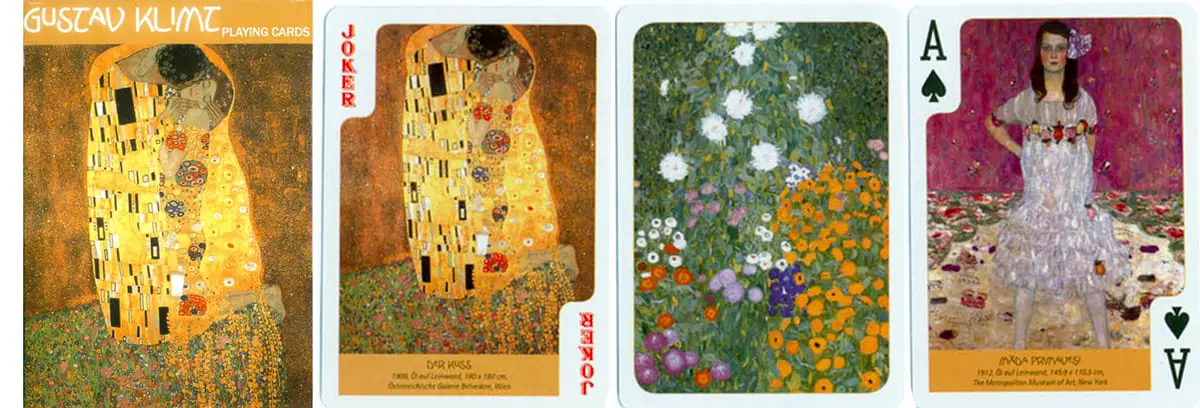
These Gustav Klimt Playing Cards do have the painting’s title, the date it was made, the museum where it is exhibited, plus the dimensions of the artwork (in cm).
do have the painting’s title, the date it was made, the museum where it is exhibited, plus the dimensions of the artwork (in cm).
The titles are not in English though, so it is not ideal, educationally, for English-speaking students.
Gustav Klimt Art Card game (Fridolin)
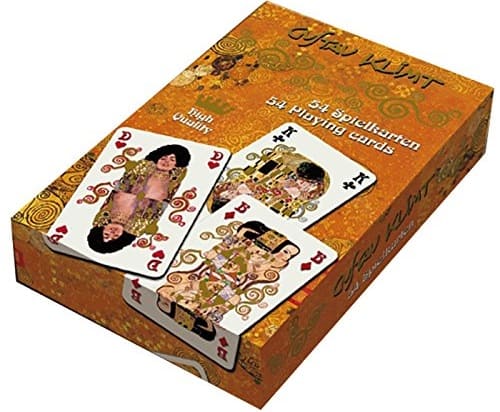
This Klimt art card game from Fridolin is different from the Piatnik game about Gustav Klimt, in that Klimt’s artworks are not directly reproduced on the cards. Instead, they are integrated as a decoration of each card (and so not in full).
is different from the Piatnik game about Gustav Klimt, in that Klimt’s artworks are not directly reproduced on the cards. Instead, they are integrated as a decoration of each card (and so not in full).
Mucha Playing Cards (Piatnik)
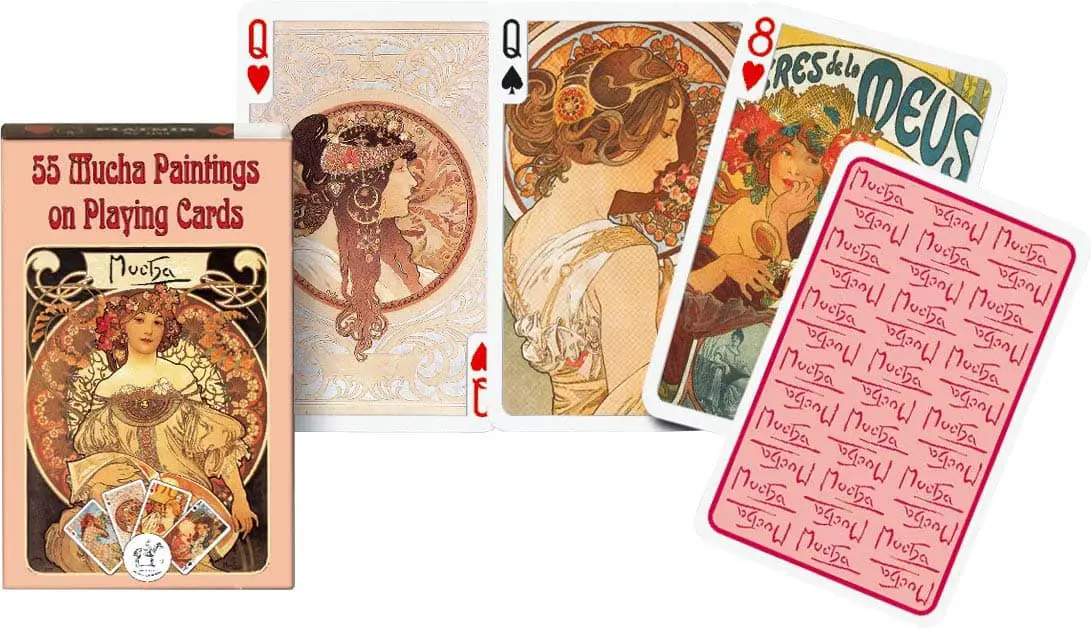
This Art Nouveau Mucha Playing Cards game is really beautiful, and I recommend it if you want to introduce students to this artist. But there is no additional information apart from the (very beautiful) artworks though.
game is really beautiful, and I recommend it if you want to introduce students to this artist. But there is no additional information apart from the (very beautiful) artworks though.
Art History Card Games and Flashcards
There are other possibilities than Playing Cards. Dedicated card games for art history have more diverse playing mechanisms. Art Flashcards enable to have a lot of available information, large prints and are still usable with rules.
Please check my two following posts that give you all the information about them:
- “15 Art History Card Games For Schools And Families” shows you all the available card games, classifying them into “Games about famous paintings”, “Games about famous artists and movements” and “Art history knowledge-based games”.
- Art History Flashcards: Check out my post “Art History Printed Flashcard for Schools and Families“, you will find that there are some awesome decks. In that post, I also give you a great bonus: 8 completely explained game rules to play with these Flashcards and transform them into awesome games.
Edudingo.com is a participant in the Amazon Services LLC Associates Program, an affiliate advertising program designed to provide a means for sites to earn advertising fees by advertising and linking to Amazon.com. We also participate in other affiliate programs which compensate us for referring traffic.


